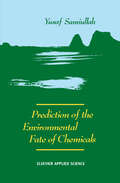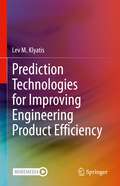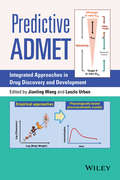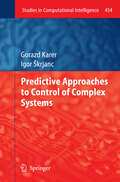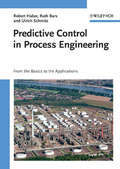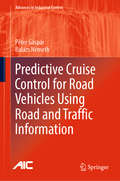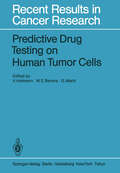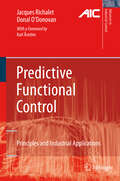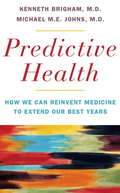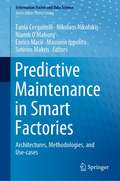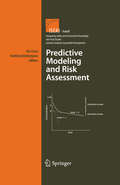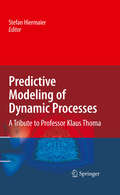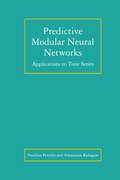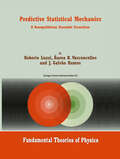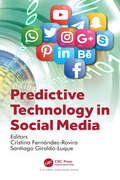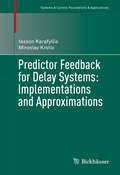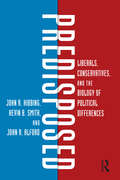- Table View
- List View
Prediction of the Environmental Fate of Chemicals
by Y. SamiullahConcern over the effects of chemicals in the environment has been increasing for many years. Environmental contamination by DDT, Aldrin, Dieldrin, mercury, PCBs, organotins and many other sub stances are all part of the public consciousness and have led to widespread attention to this topic. Some of the concerns have arisen because human health has been affected when contaminants have been consumed via the food chain-for instance in the case of 'Minimata disease' in Japan. In other cases, direct effects on other components of ecosystems have given cause for alarm. The toxic effects which any chemical can cause are a function of exposure and innate toxicity, i.e. of the ability to reach in sufficient quantity a site where a biological process can be disrupted and of the tendency to cause disruption when it gets there. The processes by which chemicals reach sites of toxic action are the subject of this book, and are a fundamental consideration in ecotoxi cology. When a chemical enters the environment e.g. via a spillage or in an effluent, it is potentially subject to a wide variety of processes which may eliminate it from the environment completely, modify it into a more or less harmful substance, or transfer it to another part of the environment. The processes involved are complex and highly variable, but it is essential to increase our understanding of them.
Prediction Technologies for Improving Engineering Product Efficiency
by Lev M. KlyatisThis book is aimed at readers who need to learn the latest solutions for interconnected simulation, testing, and prediction technologies that improve engineering product efficiency, including reliability, safety, quality, durability, maintainability, life-cycle costing and profit. It provides a detailed analysis of technologies now being used in industries such as electronics, automotive, aircraft, aerospace, off-highway, farm machinery, and others. It includes clear examples, charts, and illustrations. This book provides analyses of the simulation, testing, and prediction approaches and methodologies with descriptive, negative trends in their development. The author discusses why many current methods of simulation, testing, and prediction are not successful and describes novel techniques and tools developed for eliminating these problems. This book is a tool for engineers, managers, researches in industry, teachers, and students. Lev Klyatis, Hab. Dr.-Ing., ScD., PhD, Senior Advisor SoHaR, Inc., has been a professor at Moscow State Agricultural Engineering University, research leader and chairman of State Enterprise TESTMASH, and served on the US Technical Advisory Group for the International Electrotechnical Commission (IEC), the ISO/IEC Join Study Group in Safety Aspects of Risk Assessment, the United Nations European Economical Commission, and US-USSR Trade and Economic Council. He is presently a member of World Quality Council, the Elmer A. Sperry Board of Award, SAE International G-41 Reliability Committee, the Integrated Design and Manufacturing Committee and session chairman of SAE International World Congresses in Detroit since 2012. His vast experience and innovation enable him to create a new direction for the successful prediction of product efficiency during any given time, including accurate simulation of real-world conditions, accelerated reliability and durability testing technology, and reducing recalls. His approach has been verified in various industries, primarily automotive, farm machinery, aerospace, and aircraft industries. He has shared his new direction working as the seminar instructor and consultant to Ford, DaimlerChrysler, Nissan, Toyota, Jatko Ltd., Thermo King, Black an Dekker, NASA Research Centers, Karl Schenck, and many others. He holds over 30 patents worldwide and is the author of over 300 publications, including 15 books.
Predictive ADMET: Integrated Approaches in Drug Discovery and Development
by Jianling Wang Laszlo UrbanThis book helps readers integrate in silico, in vitro, and in vivo ADMET (absorption, distribution, metabolism, elimination and toxicity) and PK (pharmacokinetics) data with routine testing applications so that pharmaceutical scientists can diagnose ADMET problems and present appropriate recommendations to move drug discovery programs forward. The book introduces the current clinical practice for drug discovery and development along with the impact on early risk assessment; consolidates the tools and models to intelligently integrate existing in silico, in vitro and in vivo ADMET data; and demonstrates successful cases and lessons learned from real drug discovery and development. In short, it is a book aimed to provide a practical road map for drug discovery and development scientists to generate efficacious and safe drugs for unmet medical needs.
Predictive ADMET: Integrated Approaches in Drug Discovery and Development
by Jianling Wang Laszlo UrbanThis book helps readers integrate in silico, in vitro, and in vivo ADMET (absorption, distribution, metabolism, elimination and toxicity) and PK (pharmacokinetics) data with routine testing applications so that pharmaceutical scientists can diagnose ADMET problems and present appropriate recommendations to move drug discovery programs forward. The book introduces the current clinical practice for drug discovery and development along with the impact on early risk assessment; consolidates the tools and models to intelligently integrate existing in silico, in vitro and in vivo ADMET data; and demonstrates successful cases and lessons learned from real drug discovery and development. In short, it is a book aimed to provide a practical road map for drug discovery and development scientists to generate efficacious and safe drugs for unmet medical needs.
Predictive Approaches to Control of Complex Systems (Studies in Computational Intelligence #454)
by Gorazd Karer Igor ŠkrjancA predictive control algorithm uses a model of the controlled system to predict the system behavior for various input scenarios and determines the most appropriate inputs accordingly. Predictive controllers are suitable for a wide range of systems; therefore, their advantages are especially evident when dealing with relatively complex systems, such as nonlinear, constrained, hybrid, multivariate systems etc. However, designing a predictive control strategy for a complex system is generally a difficult task, because all relevant dynamical phenomena have to be considered. Establishing a suitable model of the system is an essential part of predictive control design. Classic modeling and identification approaches based on linear-systems theory are generally inappropriate for complex systems; hence, models that are able to appropriately consider complex dynamical properties have to be employed in a predictive control algorithm. This book first introduces some modeling frameworks, which can encompass the most frequently encountered complex dynamical phenomena and are practically applicable in the proposed predictive control approaches. Furthermore, unsupervised learning methods that can be used for complex-system identification are treated. Finally, several useful predictive control algorithms for complex systems are proposed and their particular advantages and drawbacks are discussed. The presented modeling, identification and control approaches are complemented by illustrative examples. The book is aimed towards researches and postgraduate students interested in modeling, identification and control, as well as towards control engineers needing practically usable advanced control methods for complex systems.
The Predictive Brain: Consciousness, Decision and Embodied Action
by Mauro MaldonatoDuring the lengthy and complex process of human evolution our ancestors had to adapt to testing situations in which survival depended on making rapid choices that subjected muscles and body to extreme tension. In order to seize a prey travelling at 36 km per hour Homo sapiens had just thousandths of a second in which to prepare the appropriate gesture. While we are no longer faced with such an environment, our brain continues to use the adaptive mechanisms, enabling us to avoid danger and sense interlocutor intentions. This book sets out to show that our brain is not only a reactive mechanism, reacting to external stimuli, but is pro-active -- allowing us to make hypotheses, anticipate consequences, and formulate expectations: in short, to wrong foot an adversary. The body and its movements are at the origin of all abstract modes of behaviour, starting from language. The evolution of motor modes of behaviour (e.g. the ability to construct and manipulate instruments) has given rise to an "embodied logic" underpinning not only action and prediction but also gestures and syllable sequences that are the basis of human communication. Some motor experiences have progressively moulded the nervous infrastructures and led to the development of symbols/metaphors used in language, coming to serve as classes of perceptions, behavioural patterns and universal linguistic conventions. Whether shaking someone's hand or writing a letter, each executive function -- controlled by nervous structures and mental procedures that process the information -- requires behaviours that are oriented to a specific end. The executive functions imply planning/selecting an action; the process is linked to an embodied cognition supported by consciousness. If consciousness is caused by specific neuronal processes and, therefore, conscious states are causally reducible to neurobiological processes, it is also true that conscious states exist at a higher level than neuron activity. For this reason it is necessary to go beyond a hierarchical idea of levels of consciousness, and to refute the idea according to which the 'mental' sphere is qualitative, subjective, and in the 'first person', while the 'physical' sphere is quantitative, objective and in the 'third person'.
The Predictive Brain: Consciousness, Decision and Embodied Action
by Mauro MaldonatoDuring the lengthy and complex process of human evolution our ancestors had to adapt to testing situations in which survival depended on making rapid choices that subjected muscles and body to extreme tension. In order to seize a prey travelling at 36 km per hour Homo sapiens had just thousandths of a second in which to prepare the appropriate gesture. While we are no longer faced with such an environment, our brain continues to use the adaptive mechanisms, enabling us to avoid danger and sense interlocutor intentions. This book sets out to show that our brain is not only a reactive mechanism, reacting to external stimuli, but is pro-active -- allowing us to make hypotheses, anticipate consequences, and formulate expectations: in short, to wrong foot an adversary. The body and its movements are at the origin of all abstract modes of behaviour, starting from language. The evolution of motor modes of behaviour (e.g. the ability to construct and manipulate instruments) has given rise to an "embodied logic" underpinning not only action and prediction but also gestures and syllable sequences that are the basis of human communication. Some motor experiences have progressively moulded the nervous infrastructures and led to the development of symbols/metaphors used in language, coming to serve as classes of perceptions, behavioural patterns and universal linguistic conventions. Whether shaking someone's hand or writing a letter, each executive function -- controlled by nervous structures and mental procedures that process the information -- requires behaviours that are oriented to a specific end. The executive functions imply planning/selecting an action; the process is linked to an embodied cognition supported by consciousness. If consciousness is caused by specific neuronal processes and, therefore, conscious states are causally reducible to neurobiological processes, it is also true that conscious states exist at a higher level than neuron activity. For this reason it is necessary to go beyond a hierarchical idea of levels of consciousness, and to refute the idea according to which the 'mental' sphere is qualitative, subjective, and in the 'first person', while the 'physical' sphere is quantitative, objective and in the 'third person'.
Predictive Control in Process Engineering: From the Basics to the Applications
by Robert Haber Ruth Bars Ulrich SchmitzDescribing the principles and applications of single input, single output and multivariable predictive control in a simple and lively manner, this practical book discusses topics such as the handling of on-off control, nonlinearities and numerical problems. It gives guidelines and methods for reducing the computational demand for real-time applications. With its many examples and several case studies (incl. injection molding machine and waste water treatment) and industrial applications (stripping column, distillation column, furnace) this is invaluable reading for students and engineers who would wish to understand and apply predictive control in a wide variety of process engineering application areas.
Predictive Control in Process Engineering: From the Basics to the Applications
by Robert Haber Ruth Bars Ulrich SchmitzDescribing the principles and applications of single input, single output and multivariable predictive control in a simple and lively manner, this practical book discusses topics such as the handling of on-off control, nonlinearities and numerical problems. It gives guidelines and methods for reducing the computational demand for real-time applications. With its many examples and several case studies (incl. injection molding machine and waste water treatment) and industrial applications (stripping column, distillation column, furnace) this is invaluable reading for students and engineers who would wish to understand and apply predictive control in a wide variety of process engineering application areas.
Predictive Cruise Control for Road Vehicles Using Road and Traffic Information
by Péter Gáspár Balázs NémethThis book focuses on the design of a multi-criteria automated vehicle longitudinal control system as an enhancement of the adaptive cruise control system. It analyses the effects of various parameters on the average traffic speed and the traction force of the vehicles in mixed traffic from a macroscopic point of view, and also demonstrates why research and development in speed control and predictive cruise control is important. The book also summarises the main steps of the system’s robust control design, from the modelling to its synthesis, and discusses both the theoretical background and the practical computation method of the control invariant sets.The book presents the analysis and verification of the system both in a simulation environment and under real-world conditions. By including the systematic design of the predictive cruise control using road and traffic information, it shows how optimization criteria can lead to multiobjective solutions, and the advanced optimization and control design methods required. The book focuses on a particular method by which the unfavourable effect of the traffic flow consideration can be reduced. It also includes simulation examples in which the speed design is performed, while the analysis is carried out in simulation and visualization environments.This book is a valuable reference for researchers and control engineers working on traffic control, vehicle control and control theory. It is also of interest to students and academics as it provides an overview of the strong interaction between the traffic flow and an individual vehicle cruising from both a microscopic and a macroscopic point of view.
Predictive Drug Testing on Human Tumor Cells (Recent Results in Cancer Research #94)
by Victor Hofmann, Michael E. Berens and Georg MartzPredictive drug testing on human tumor cells in order to define the appropriate chemotherapy will remain imperative as long as the anticancer agents available are few in number and show only limited activity. The advantages of an effective test would lie in obviating the need for testing antineoplastic agents on large cohorts of patients for assessment of drug activity (phase II studies) and in allowing determination of optimal use of anticancer agents (phase III trials). Such an in vitro test could help to better define dose and schedule of drugs preclinically. The additive value of individual drugs could be determined on tumor cells in vitro in order to define the best combination chemotherapy in vivo. Test-directed therapy would avoid unnecessary drug-related morbidity in patients with refractory tumors. Chemotherapy treatment would be more than justified even with side effects if palliation or even prolonged survival could be anticipated as a result. The benefits of predictive drug testing on human tumor cells would extend beyond improvement of individual patient treatment if the testing helped to identify new active agents. This spectrum of benefits to the entire field of oncology pro vides tremendous motivation for the development of such testing. Although a number of chemosensitivity tests have been proposed since the advent of modern anticancer chemotherapy, interest has been renewed by the possibility of cloning human tumor cells on agar plates, with a view to testing drug activity on cells with high pro liferation capacity.
Predictive Functional Control: Principles and Industrial Applications (Advances in Industrial Control)
by Jacques Richalet Donal O'Donovanfirst industrial application of MPC was in 1973. A key motivation was to provide better performance than could be obtained with the widely-used PID controller whilst making it easy to replace the PID controller unit or module with his new algorithm. It was the advent of digital control technology and the use of software control algorithms that made this replacement easier and more acceptable to process engineers. A decade of industrial practice with PFC was reported in the archival literature by Jacques Richalet et al. in 1978 in an important seminal Automatica paper. Around this time, Cutler and Ramaker published the dynamic matrix control algorithm that also used knowledge of future reference signals to determine a sequence of control signal adjustment. Thus, the theoretical and practical development of predictive control methods was underway and subsequent developments included those of generalized predictive control, and the whole armoury of MPC methods. Jacques Richalet’s approach to PFC was to seek an algorithm that was: • easy to understand; • easy to install; • easy to tune and optimise. He sought a new modular control algorithm that could be readily used by the control-technician engineer or the control-instrument engineer. It goes without saying that this objective also forms a good market strategy.
Predictive Health: How We Can Reinvent Medicine to Extend Our Best Years
by Kenneth L. Brigham Michael M. JohnsOur health care system is crippled by desperate efforts to prevent the inevitable. A third of the national Medicare budget—nearly 175 billion—is spent on the final year of life, and a third of that amount on the final month, often on expensive (and futile) treatments. Such efforts betray a fundamental flaw in how we think about healthcare: we squander resources on hopeless situations, instead of using them to actually improve health.In Predictive Health, distinguished doctors Kenneth Brigham and Michael M.E. Johns propose a solution: invest earlier—and use science and technology to make healthcare more available and affordable. Every child would begin life with a post-natal genetic screen, when potential risk—say for type II diabetes or heart disease—would be found. More data on biology, behavior, and environment would be captured throughout her life. Using this information, health-care workers and the people they care for could forge personal strategies for healthier living long before a small glitch blows up into major disease. This real health care wouldn&’t just replace much of modern disease care—it would make it obsolete. The result, according to Brigham and Johns, will be a life defined by a long stay at top physical and mental form, rather than an early peak and long decline. Accomplishing this goal will require new tools, new clinics, fewer doctors and more mentors, smarter companies, and engaged patients. In short, it will require a revolution. Thanks to a decade-long collaboration between Brigham, Johns and others, it is already underway.An optimistic plan for reducing or eliminating many chronic diseases as well as reforming our faltering medical system, Predictive Health is a deeply knowledgeable, deeply humane proposal for how we can reallocate expenses and resources to prolong the best years of life, rather than extending the worst.
Predictive Maintenance in Smart Factories: Architectures, Methodologies, and Use-cases (Information Fusion and Data Science)
by Tania Cerquitelli Nikolaos Nikolakis Niamh O’Mahony Enrico Macii Massimo Ippolito Sotirios MakrisThis book presents the outcome of the European project "SERENA", involving fourteen partners as international academics, technological companies, and industrial factories, addressing the design and development of a plug-n-play end-to-end cloud architecture, and enabling predictive maintenance of industrial equipment to be easily exploitable by small and medium manufacturing companies with a very limited data analytics experience. Perspectives and new opportunities to address open issues on predictive maintenance conclude the book with some interesting suggestions of future research directions to continue the growth of the manufacturing intelligence.
Predictive Microbiology in Foods (SpringerBriefs in Food, Health, and Nutrition #5)
by Fernando Perez-Rodriguez Antonio ValeroPredictive microbiology is a recent area within food microbiology, which studies the responses of microorganisms in foods to environmental factors (e.g., temperature, pH) through mathematical functions. These functions enable scientists to predict the behavior of pathogens and spoilage microorganisms under different combinations of factors. The main goal of predictive models in food science is to assure both food safety and food quality. Predictive models in foods have developed significantly in the last 20 years due to the emergence of powerful computational resources and sophisticated statistical packages. This book presents the concepts, models, most significant advances, and future trends in predictive microbiology. It will discuss the history and basic concepts of predictive microbiology. The most frequently used models will be explained, and the most significant software and databases (e.g., Combase, Sym’Previus) will be reviewed. Quantitative Risk Assessment, which uses predictive modeling to account for the transmission of foodborne pathogens across the food chain, will also be covered.
Predictive Modeling and Risk Assessment (Integrating Food Science and Engineering Knowledge Into the Food Chain #4)
by Rui CostaThe single most important task of food scientists and the food industry as a whole is to ensure the safety of foods supplied to consumers. Recent trends in global food production, distribution and preparation call for increased emphasis on hygienic practices at all levels and for increased research in food safety in order to ensure a safer global food supply. The ISEKI-Food book series is a collection of books where various aspects of food safety and environmental issues are introduced and reviewed by scientists specializing in the field. In all of the books a special emp- sis was placed on including case studies applicable to each specific topic. The books are intended for graduate students and senior level undergraduate students as well as professionals and researchers interested in food safety and environmental issues applicable to food safety. The idea and planning of the books originates from two working groups in the European thematic network “ISEKI-Food” an acronym for “Integrating Safety and Environmental Knowledge In to Food Studies”. Participants in the ISEKI-Food network come from 29 countries in Europe and most of the institutes and univer- ties involved with Food Science education at the university level are represented. Some international companies and non teaching institutions have also participated in the program. The ISEKI-Food network is coordinated by Professor Cristina Silva at The Catholic University of Portugal, College of Biotechnology (Escola) in Porto. The program has a web site at: http://www. esb. ucp. pt/iseki/.
Predictive Modeling of Dynamic Processes: A Tribute to Professor Klaus Thoma
by Stefan HiermaierPredictive Modeling of Dynamic Processes provides an overview of hydrocode technology, applicable to a variety of industries and areas of engineering design. Covering automotive crash, blast impact, and hypervelocity impact phenomena, this volume offers readers an in-depth explanation of the fundamental code components. Chapters include informative introductions to each topic, and explain the specific requirements pertaining to each predictive hydrocode. Successfully blending crash simulation, hydrocode technology and impact engineering, this volume fills a gap in the current competing literature available.
Predictive Modular Neural Networks: Applications to Time Series (The Springer International Series in Engineering and Computer Science #466)
by Vassilios Petridis Athanasios KehagiasThe subject of this book is predictive modular neural networks and their ap plication to time series problems: classification, prediction and identification. The intended audience is researchers and graduate students in the fields of neural networks, computer science, statistical pattern recognition, statistics, control theory and econometrics. Biologists, neurophysiologists and medical engineers may also find this book interesting. In the last decade the neural networks community has shown intense interest in both modular methods and time series problems. Similar interest has been expressed for many years in other fields as well, most notably in statistics, control theory, econometrics etc. There is a considerable overlap (not always recognized) of ideas and methods between these fields. Modular neural networks come by many other names, for instance multiple models, local models and mixtures of experts. The basic idea is to independently develop several "subnetworks" (modules), which may perform the same or re lated tasks, and then use an "appropriate" method for combining the outputs of the subnetworks. Some of the expected advantages of this approach (when compared with the use of "lumped" or "monolithic" networks) are: superior performance, reduced development time and greater flexibility. For instance, if a module is removed from the network and replaced by a new module (which may perform the same task more efficiently), it should not be necessary to retrain the aggregate network.
Predictive Species and Habitat Modeling in Landscape Ecology: Concepts and Applications
by C. Ashton Drew, Yolanda F. Wiersma and Falk HuettmannMost projects in Landscape Ecology, at some point, define a species-habitat association. These models are inherently spatial, dealing with landscapes and their configurations. Whether coding behavioral rules for dispersal of simulated organisms through simulated landscapes, or designing the sampling extent of field surveys and experiments in real landscapes, landscape ecologists must make assumptions about how organisms experience and utilize the landscape. These convenient working postulates allow modelers to project the model in time and space, yet rarely are they explicitly considered. The early years of landscape ecology necessarily focused on the evolution of effective data sources, metrics, and statistical approaches that could truly capture the spatial and temporal patterns and processes of interest. Now that these tools are well established, we reflect on the ecological theories that underpin the assumptions commonly made during species distribution modeling and mapping. This is crucial for applying models to questions of global sustainability. Due to the inherent use of GIS for much of this kind of research, and as several authors’ research involves the production of multicolored map figures, there would be an 8-page color insert. Additional color figures could be made available through a digital archive, or by cost contributions of the chapter authors. Where applicable, would be relevant chapters’ GIS data and model code available through a digital archive. The practice of data and code sharing is becoming standard in GIS studies, is an inherent method of this book, and will serve to add additional research value to the book for both academic and practitioner audiences.
Predictive Statistical Mechanics: A Nonequilibrium Ensemble Formalism (Fundamental Theories of Physics #122)
by Roberto Luzzi Áurea R. Vasconcellos J. Galvão RamosChapters 1 to 5 include a description of the philosophy, foundations, and construction (methodology) of the formalism, including the derivation of a nonequilibrium grand-canonical ensemble for far-from-equilibrium systems as well as the derivation of a quantum nonlinear kinetic theory and a response function theory together with a theory of scattering. In chapter 6 applications of the theory are cataloged, making comparisons with experimental data (a basic step for the validation of any theory). Chapter 7 is devoted to the description of irreversible thermodynamics, providing a far-reaching generalization of Informational-Statistical Thermodynamics. The last chapter gives an overall picture of the formalism, and questions and criticisms related to it are discussed.
Predictive Technology in Social Media
by Cristina Fernández-RoviraCan behaviour on social media predict future purchase patterns? Can what we click on social media foresee which political party will we vote for? Can the information we share on our wall foretell the next series I might want to watch? Can the likes on Instagram and Facebook predict the time one will spend on digital platforms in the next hour? The answer is no longer science fiction. It points to the ability of mainstream social media platforms such as Facebook and Twitter to be able to deliver specialised advertising services to highly targeted audience segments controlled by the billions of devices that flood our daily lives. At the same time, it highlights a more relevant problem: can social media guide, suggest or impose a certain behaviour or thought? Everything seems to indicate that they can do it.Predictive Technology in Social Media comprises 10 essays that reflect on the power of the predictive technology of social media in culture, entertainment, marketing, economics and politics. It shows, from a humanistic and critical perspective, the predictive possibilities of social media platforms, as well as the risks this entails for cultural plurality, everyday consumption, the monopolistic concentration of the economy and attention, and democracy. The text is an invitation to think, as citizens, about the unbridled power we have ceded to digital platforms. A new voice to warn about the greatest concentration of communicative power ever seen in the history of humanity.
Predictive Technology in Social Media
by Cristina. Fernández-Rovira Santiago Giraldo-LuqueCan behaviour on social media predict future purchase patterns? Can what we click on social media foresee which political party will we vote for? Can the information we share on our wall foretell the next series I might want to watch? Can the likes on Instagram and Facebook predict the time one will spend on digital platforms in the next hour? The answer is no longer science fiction. It points to the ability of mainstream social media platforms such as Facebook and Twitter to be able to deliver specialised advertising services to highly targeted audience segments controlled by the billions of devices that flood our daily lives. At the same time, it highlights a more relevant problem: can social media guide, suggest or impose a certain behaviour or thought? Everything seems to indicate that they can do it.Predictive Technology in Social Media comprises 10 essays that reflect on the power of the predictive technology of social media in culture, entertainment, marketing, economics and politics. It shows, from a humanistic and critical perspective, the predictive possibilities of social media platforms, as well as the risks this entails for cultural plurality, everyday consumption, the monopolistic concentration of the economy and attention, and democracy. The text is an invitation to think, as citizens, about the unbridled power we have ceded to digital platforms. A new voice to warn about the greatest concentration of communicative power ever seen in the history of humanity.
Predictor Feedback for Delay Systems: Implementations and Approximations (Systems & Control: Foundations & Applications)
by Iasson Karafyllis Miroslav KrsticThis monograph bridges the gap between the nonlinear predictor as a concept and as a practical tool, presenting a complete theory of the application of predictor feedback to time-invariant, uncertain systems with constant input delays and/or measurement delays. It supplies several methods for generating the necessary real-time solutions to the systems’ nonlinear differential equations, which the authors refer to as approximate predictors.Predictor feedback for linear time-invariant (LTI) systems is presented in Part I to provide a solid foundation on the necessary concepts, as LTI systems pose fewer technical difficulties than nonlinear systems. Part II extends all of the concepts to nonlinear time-invariant systems. Finally, Part III explores extensions of predictor feedback to systems described by integral delay equations and to discrete-time systems.The book’s core is the design of control and observer algorithms with which global stabilization, guaranteed in the previous literature with idealized (but non-implementable) predictors, is preserved with approximate predictors developed in the book.An applications-driven engineer will find a large number of explicit formulae, which are given throughout the book to assist in the application of the theory to a variety of control problems. A mathematician will find sophisticated new proof techniques, which are developed for the purpose of providing global stability guarantees for the nonlinear infinite-dimensional delay system under feedback laws employing practically implementable approximate predictors.Researchers working on global stabilization problems for time-delay systems will find this monograph to be a helpful summary of the state of the art, while graduate students in the broad field of systems and control will advance their skills in nonlinear control design and the analysis of nonlinear delay systems.
Predisposed: Liberals, Conservatives, and the Biology of Political Differences
by John R. Hibbing Kevin B. Smith John R. AlfordBuried in many people and operating largely outside the realm of conscious thought are forces inclining us toward liberal or conservative political convictions. Our biology predisposes us to see and understand the world in different ways, not always reason and the careful consideration of facts. These predispositions are in turn responsible for a significant portion of the political and ideological conflict that marks human history. With verve and wit, renowned social scientists John Hibbing, Kevin Smith, and John Alford—pioneers in the field of biopolitics—present overwhelming evidence that people differ politically not just because they grew up in different cultures or were presented with different information. Despite the oft-heard longing for consensus, unity, and peace, the universal rift between conservatives and liberals endures because people have diverse psychological, physiological, and genetic traits. These biological differences influence much of what makes people who they are, including their orientations to politics. Political disputes typically spring from the assumption that those who do not agree with us are shallow, misguided, uninformed, and ignorant. Predisposed suggests instead that political opponents simply experience, process, and respond to the world differently. It follows, then, that the key to getting along politically is not the ability of one side to persuade the other side to see the error of its ways but rather the ability of each side to see that the other is different, not just politically, but physically. Predisposed will change the way you think about politics and partisan conflict. As a bonus, the book includes a "Left/Right 20 Questions" game to test whether your predispositions lean liberal or conservative.
Predisposed: Liberals, Conservatives, and the Biology of Political Differences
by John R. Hibbing Kevin B. Smith John R. AlfordBuried in many people and operating largely outside the realm of conscious thought are forces inclining us toward liberal or conservative political convictions. Our biology predisposes us to see and understand the world in different ways, not always reason and the careful consideration of facts. These predispositions are in turn responsible for a significant portion of the political and ideological conflict that marks human history. With verve and wit, renowned social scientists John Hibbing, Kevin Smith, and John Alford—pioneers in the field of biopolitics—present overwhelming evidence that people differ politically not just because they grew up in different cultures or were presented with different information. Despite the oft-heard longing for consensus, unity, and peace, the universal rift between conservatives and liberals endures because people have diverse psychological, physiological, and genetic traits. These biological differences influence much of what makes people who they are, including their orientations to politics. Political disputes typically spring from the assumption that those who do not agree with us are shallow, misguided, uninformed, and ignorant. Predisposed suggests instead that political opponents simply experience, process, and respond to the world differently. It follows, then, that the key to getting along politically is not the ability of one side to persuade the other side to see the error of its ways but rather the ability of each side to see that the other is different, not just politically, but physically. Predisposed will change the way you think about politics and partisan conflict. As a bonus, the book includes a "Left/Right 20 Questions" game to test whether your predispositions lean liberal or conservative.
